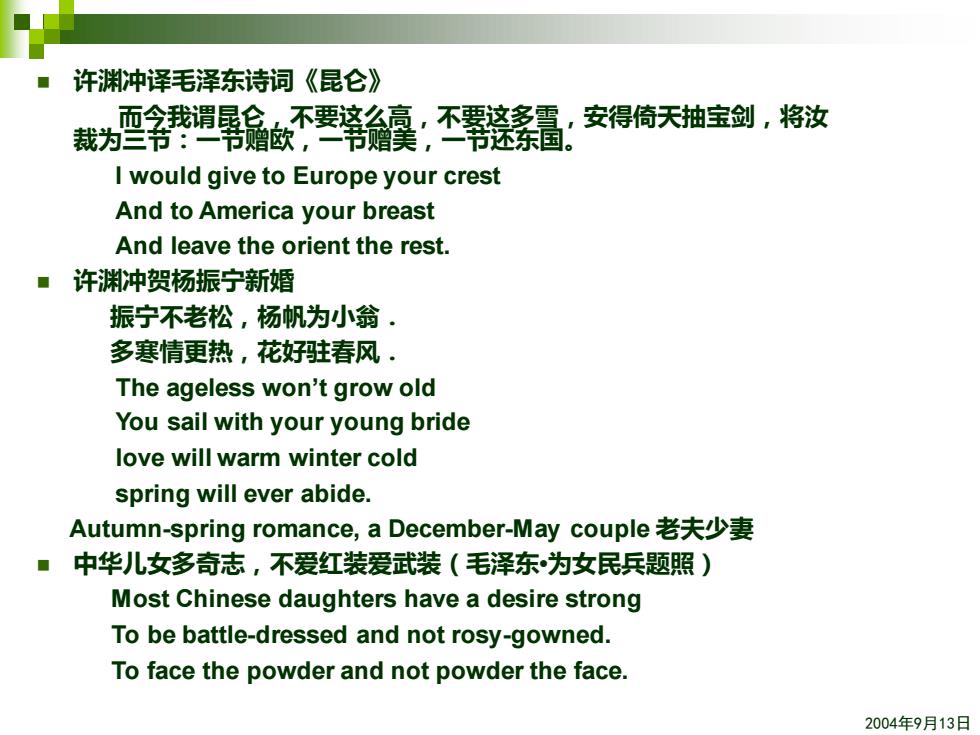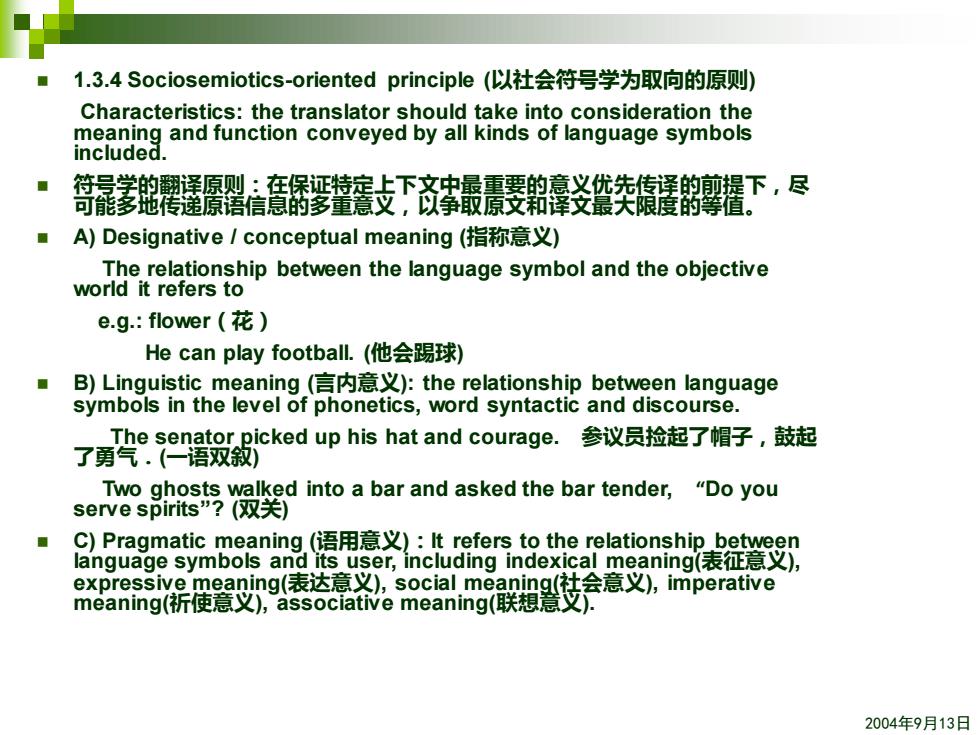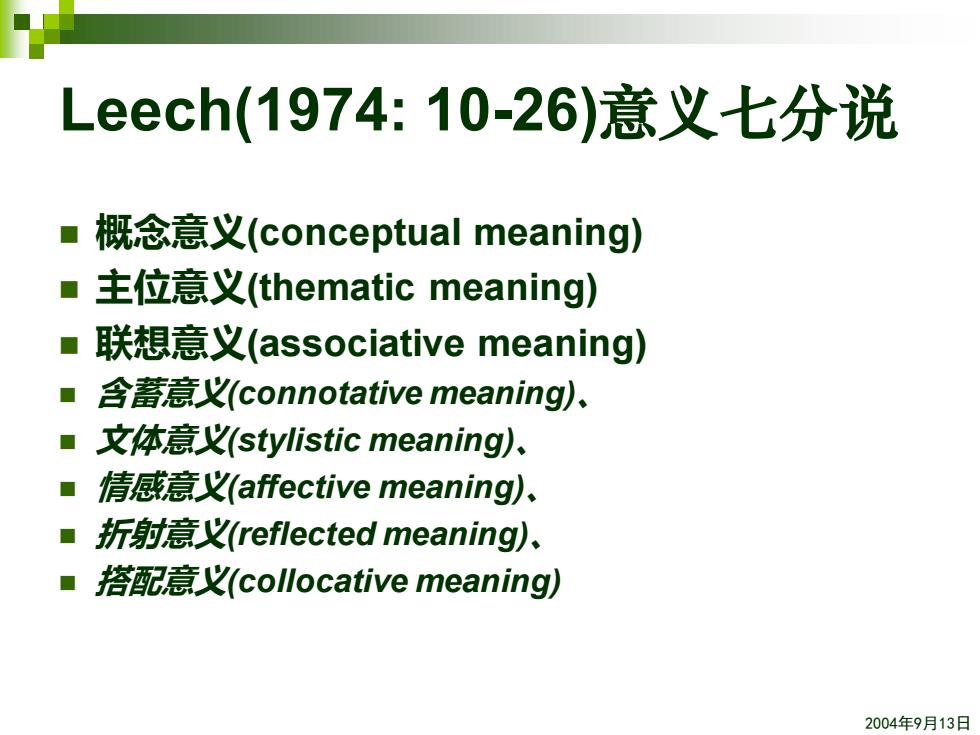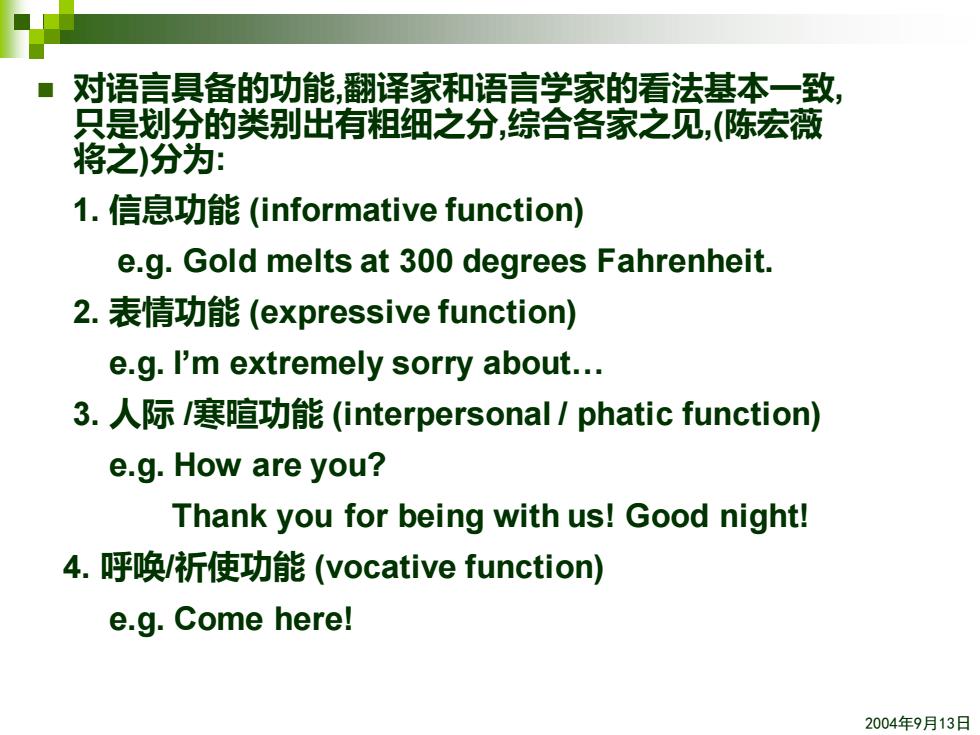
■ 1.3.3 Aesthetics-oriented principle(以美学为取向的原 则) 傅雷:(《高老头重译本序》)神似(similarity in spirit) 傅雷先生模拟我国传统的绘画理论,提出翻译应当像临画, 所求的不在形似而在神似,强调“重神似不重形似”。 钱钟书:化境(sublimation/reincarnation) 许渊冲:三美”(音美,意美,形美the phonetic beauty,the semantic beauty,the formal beauty 2004年9月13日
2004年9月13日 ◼ 1.3.3Aesthetics-oriented principle (以美学为取向的原 则) ◼ 傅雷 :(《高老头重译本序》) 神似(similarity in spirit) 傅雷先生模拟我国传统的绘画理论,提出翻译应当像临画, 所求的不在形似而在神似,强调“重神似不重形似” 。 ◼ 钱钟书:化境 (sublimation / reincarnation) ◼ 许渊冲:“三美”(音美,意美,形美 the phonetic beauty, the semantic beauty, the formal beauty)

许渊冲译毛泽东诗词《昆仑》 而今我谓昆仑,不要这么高,不要这多雪, 安得倚天抽宝剑,将汝 裁为三节:一节赠欧,一节赠美,一节还东国。 I would give to Europe your crest And to America your breast And leave the orient the rest. ■ 许渊冲贺杨振宁新婚 振宁不老松,杨帆为小翁 多寒情更热,花好驻春风· The ageless won't grow old You sail with your young bride love will warm winter cold spring will ever abide. Autumn-spring romance,a December-.May couple老夫少妻 中华儿女多奇志,不爱红装爱武装(毛泽东·为女民兵题照) Most Chinese daughters have a desire strong To be battle-dressed and not rosy-gowned. To face the powder and not powder the face. 2004年9月13日
2004年9月13日 ◼ 许渊冲译毛泽东诗词《昆仑》 而今我谓昆仑,不要这么高,不要这多雪,安得倚天抽宝剑,将汝 裁为三节:一节赠欧,一节赠美,一节还东国。 I would give to Europe your crest And to America your breast And leave the orient the rest. ◼ 许渊冲贺杨振宁新婚 振宁不老松,杨帆为小翁. 多寒情更热,花好驻春风. The ageless won’t grow old You sail with your young bride love will warm winter cold spring will ever abide. Autumn-spring romance, a December-May couple 老夫少妻 ◼ 中华儿女多奇志,不爱红装爱武装(毛泽东•为女民兵题照) Most Chinese daughters have a desire strong To be battle-dressed and not rosy-gowned. To face the powder and not powder the face

1.3.4 Sociosemiotics-oriented principle(以社会符号学为取向的原则) Characteristics:the translator should take into consideration the meaning and function conveyed by all kinds of language symbols included. 符号学的翻译原则:在保证特定上下文中最重要的意义优先传译的前提下,尽 可能多地传递原语信息的多重意义,以争取原文和译文最大限度的等值。 A)Designative conceptual meaning(指称意义) The relationship between the language symbol and the objective world it refers to e.g:flower(花) He can play footbal.(他会踢球) B)Linguistic meaning(言内意义):the relationship between language symbols in the level of phonetics,word syntactic and discourse. _The senator.picked up his hat and courage.参议员捡起了帽子,鼓起 了勇气.(一语双叙) Two ghosts walked into a bar and asked the bar tender,"Do you serve spirits”?(双关) C)Pragmatic meaning.(语用意义):It refers to the relationship between language symbols and its user,including indexical meaning表征意义), expressive meaning(表达意义),social meaning(t会意义),imperative meaning(祈使意义),associative meaning(联想意义 2004年9月13日
2004年9月13日 ◼ 1.3.4 Sociosemiotics-oriented principle (以社会符号学为取向的原则) Characteristics: the translator should take into consideration the meaning and function conveyed by all kinds of language symbols included. ◼ 符号学的翻译原则:在保证特定上下文中最重要的意义优先传译的前提下,尽 可能多地传递原语信息的多重意义,以争取原文和译文最大限度的等值。 ◼ A) Designative / conceptual meaning (指称意义) The relationship between the language symbol and the objective world it refers to e.g.: flower(花) He can play football. (他会踢球) ◼ B) Linguistic meaning (言内意义): the relationship between language symbols in the level of phonetics, word syntactic and discourse. The senator picked up his hat and courage. 参议员捡起了帽子,鼓起 了勇气.(一语双叙) Two ghosts walked into a bar and asked the bar tender, “Do you serve spirits”? (双关) ◼ C) Pragmatic meaning (语用意义):It refers to the relationship between language symbols and its user, including indexical meaning(表征意义), expressive meaning(表达意义), social meaning(社会意义), imperative meaning(祈使意义), associative meaning(联想意义)

Leech(1974:10-26)意义七分说 概念意义(conceptual meaning) ■ 主位意义(thematic meaning) 联想意义(associative meaning) 含蓄意义(connotative meaning), ■ 文体意义(stylistic meaning), ■ 情感意义(affective meaning). ■ 折射意义(reflected meaning)、 搭配意义(collocative meaning) 2004年9月13日
2004年9月13日 Leech(1974: 10-26)意义七分说 ◼ 概念意义(conceptual meaning) ◼ 主位意义(thematic meaning) ◼ 联想意义(associative meaning) ◼ 含蓄意义(connotative meaning)、 ◼ 文体意义(stylistic meaning)、 ◼ 情感意义(affective meaning)、 ◼ 折射意义(reflected meaning)、 ◼ 搭配意义(collocative meaning)

对语言具备的功能,翻译家和语言学家的看法基本一致, 只是划分的类别出有粗细之分,综合各家之见,(陈宏薇 将之)分为: 1.信息功能(informative function) e.g.Gold melts at 300 degrees Fahrenheit. 2.表情功能(expressive function) e.g.I'm extremely sorry about. 3.人际/寒暄功能(interpersonal phatic function) e.g.How are you? Thank you for being with us!Good night! 4.呼唤/祈使功能(vocative function) e.g.Come here! 2004年9月13日
2004年9月13日 ◼ 对语言具备的功能,翻译家和语言学家的看法基本一致, 只是划分的类别出有粗细之分,综合各家之见,(陈宏薇 将之)分为: 1. 信息功能 (informative function) e.g. Gold melts at 300 degrees Fahrenheit. 2. 表情功能 (expressive function) e.g. I’m extremely sorry about. 3. 人际 /寒暄功能 (interpersonal / phatic function) e.g. How are you? Thank you for being with us! Good night! 4. 呼唤/祈使功能 (vocative function) e.g. Come here!